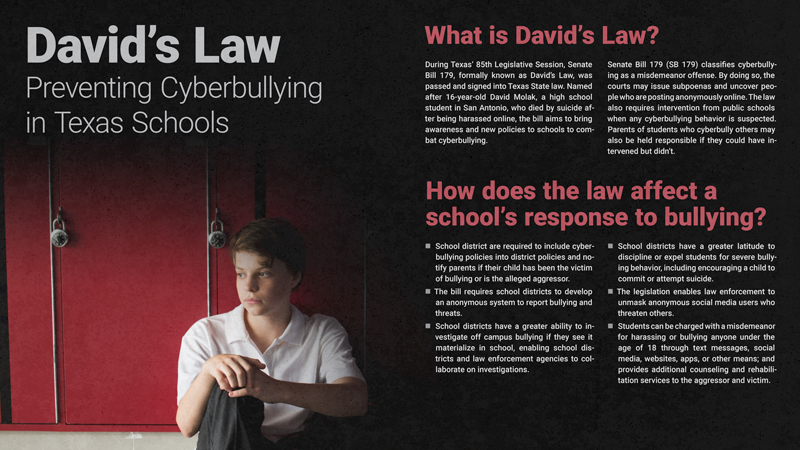Bullying Prevention
Frisco ISD believes that a safe and civil environment is necessary for students to learn and achieve high academic standards. We realize having a safe and welcoming school climate is a prerequisite to learning. Bullying, harassment and other aggressive behaviors is conduct that disrupts both a student’s ability to learn and a schools ability to educate its students in a safe environment. Demonstration of appropriate behavior, treating others with civility and respect, and refusing to tolerate bullying or harassment is expected by staff and students alike. It’s our goal to produce an environment where all students feel safe and are confident in achieving success in school.
David's Law Brochure

Historical Look at Bullying Prevention
Bullying is not a new phenomenon. It’s been around since the beginning of time. Most adults can usually recall incidents of bullying from their own schooldays. Either, they were bullied, they were the bully, or they were the bystander. For many of us, it’s not a pleasant memory. In addition, historically, bullying was thought of as “kids being kids,” “it’s normal behavior,” or “they probably deserved it.” Fortunately, in today’s world, those beliefs have changed. There’s nothing “normal” about people intentionally hurting each other and no one deserves to be bullied. It’s deviant, destructive, and wrong. Due to this paradigm shift, schools across the country take proactive measures in responding to bullying. In Frisco ISD, all campuses are trained to use the Olweus Bullying Prevention Program.
The Olweus Bullying Prevention Program
With over thirty-five years of research and successful implementation all over the world, The Olweus Bullying Prevention Program (OBPP) is a whole-school program that has been proven to prevent or reduce bullying throughout a school setting. The program, used in grades k-12, was developed by bullying prevention pioneer Dr. Dan Olweus of Norway. The OBPP serves as the main source of information for most state laws on bullying prevention.
The OBPP is not a curriculum, but a program that deals with bullying at the school wide, classroom, individual, and community levels. As part of the program, staff and students are trained annually, each campus has a bullying prevention committee and there is a heavy focus placed on building a positive school climate. The Olweus Bullying Prevention Program is designed to improve peer relations and make schools safer, more positive places for students to learn and develop. Goals of the program include:
-
Reducing existing bullying problems among students
-
Preventing the development of new bullying problems
-
Achieving better peer relations at school
No bullying prevention program will completely eliminate bullying, but our goal is to decrease the possibility that it does occur and respond appropriately when an incident takes place.
Click here for more information on The Olweus Bullying Prevention Program.
The Differences Between Bullying and Conflict
It seems today the media, and often educators, label any type of aggression or disagreement between people as bullying. If two students fight . . . it’s bullying. If one football team beats the other team too badly, it’s bullying. If one student doesn’t want to play with another student, it’s bullying. But, many times, what’s called bullying is not bullying at all. For example, bullying is not actually about conflict or anger. You do not have to be angry at someone to bully them. Bullying tends to be more about arrogance, control, and power. It’s the feeling that I’m better than you and I have a right to treat you this way. All bullying is mean, but not all mean behavior is bullying. So, if bullying is not the same as pure peer aggression or conflict, what is it?
Click here for more information.
When Does Bullying Become Harassment?
The Office for Civil Rights and the Department of Justice have stated that bullying may also be considered harassment when it is based on a student’s race, color, national origin, sex, religion, or disability; Or when the same person is repeatedly targeted by another student (or group of students). Harassing behaviors may include:
-
Unwelcome conduct such as: Verbal abuse, i.e., name-calling, epithets, slurs, etc.
-
Graphic or written statements
-
Threats
-
Physical assault
-
Other conduct that may be physically threatening, harmful, or humiliating
How Do I Make a Report of Bullying?
In our district, students/parents have the ability to file an online or offline incident report. Students are informed at the beginning of school, as well as periodically during the school year, how to file a report of bullying.
More information on How to Make a Bullying Report
Sources
Stan Davis, Schools Where Everyone Belongs, 2007
Dan Olweus, Bullying at School: What We Know and What We Can Do, 1993.
Allan Beane, The Bully Free Classroom, 1999
Stop Bullying Now! U.S. Department of Health and Human Services (www.stopbullying.gov)
Jonathan D. Rogers, Confronting Bullies on the Digital Schoolyard (Policy Matters Journal Fall 2009).
STOP Cyberbullying: Parry Aftab, Parry Aftab's guide for schools on Cyberbullying.
Nancy Willard, Cyber-Savey Teens: Helping Young People learn to Use the Internet Safely and Responsibly, March 2007.
Nancy Willard, Cyberbullying and Cyberthreats: Effectively Managing Internet Use Risks in Schools, January 2007.
National Crime Prevention Council, Bullying Prevention and Intervention, Principal Leadership Magazine, Vol 4, Number 1, September 2003
National Crime Prevention Council, Stop Cyberbullying Before it Starts, 2010